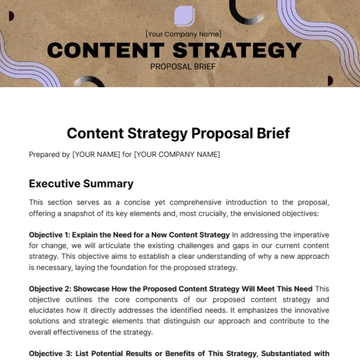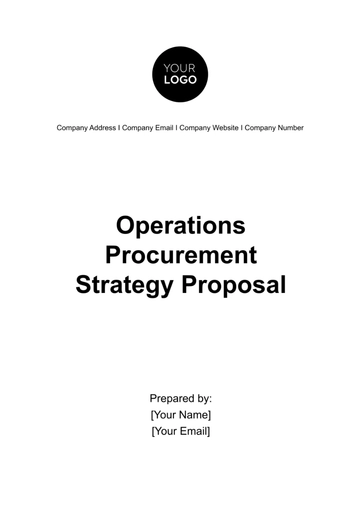Free Sales Proposal for Revamping Analytics Strategy

Analytics Strategy
I. Introduction
This proposal outlines a structured plan to transition from your current analytics setup to a more robust, reliable, and real-time data architecture. It provides an overview of the key challenges your company faces and delivers targeted solutions designed to make your analytics endeavors more effective and efficient.
III. Executive Summary
In an increasingly competitive and data-driven business environment, an effective analytics strategy is no longer optional—it is a necessity. Our proposal aims to revamp your existing analytics framework to make it more integrated, accurate, and real-time. The enhancements will pave the way for agile decision-making, increased operational efficiency, and a maximized return on investment (ROI).
Within the first year post-implementation, we project a [25%] improvement in decision-making speed, a [35%] rise in operational efficiency, and cost savings estimated at [$50,000]. By partnering with [Your Company Name], you can transform your analytics capabilities to sustain a competitive edge and drive measurable business results.
IV. Current Analytics Challenges
The analytics infrastructure at [Your Company Name] is confronted with several significant challenges that compromise the ability to derive actionable insights effectively. Below we delve into each obstacle, providing a comprehensive view of its impact on your organization's strategic and operational levels.
Data Silos: Data residing in isolated repositories hinders a unified view across various departments. This lack of interconnectivity limits cross-functional analytics and results in missed opportunities for identifying business trends and optimizing operations. Inability to correlate data across departments could lead to poor decision-making and lost business opportunities.
Inaccurate Reporting: Existing issues in data quality and integrity lead to erroneous reports, which are the basis for key business decisions. Inaccurate reporting can misinform strategy, leading to poor allocation of resources and investments. Erroneous data not only skews perceptions but also hampers your ability to meet key performance indicators (KPIs) effectively.
Lack of Real-time Analytics: The absence of real-time analytics means delays in capturing and responding to market changes. In today’s fast-paced business landscape, the ability to make immediate decisions based on real-time data is crucial for maintaining a competitive edge. The lag in real-time decision-making can result in lost opportunities and reduced responsiveness to market changes.
By addressing these challenges head-on, [Your Company Name] can dramatically improve its analytics capabilities, thereby gaining a strategic advantage in the marketplace.
V. Proposed Analytics Solutions
Our approach to revamping your analytics strategy is modular, allowing for a phased implementation that minimizes disruption to your existing operations. Below is a detailed look into each proposed solution module, including its scope, underlying technology, and targeted outcomes.
Solution Overview:
Module | Duration | Estimated Cost |
|---|---|---|
Data Integration | 2 Weeks | $20,000 |
Data Integration: We propose to integrate disparate data sources across various departments into a centralized data warehouse. Utilizing technologies like ETL (Extract, Transform, Load) processes, we aim to break down existing data silos and enable seamless data flow. This module aims to address the challenge of data silos by providing a unified view of organizational data, thereby enabling cross-functional analytics.
Technologies Involved:
SQL Server Integration Services (SSIS)
Apache Nifi
Python scripts for custom ETL
Data Accuracy: This module will involve data cleaning, validation, and integrity checks. We will utilize machine learning algorithms to identify outliers and inconsistencies, thereby enhancing data accuracy. Improved data quality will address the issue of inaccurate reporting, thereby enabling more reliable decision-making processes.
Technologies Involved:
Python libraries like Pandas and NumPy for data manipulation
ML algorithms for anomaly detection
Real-time Analytics: We propose the implementation of real-time analytics dashboards using Business Intelligence tools. These dashboards will display key performance indicators and other metrics, updated in real-time, to enable quick decision-making. The ability to make immediate, data-driven decisions will address the challenge of a lack of real-time analytics, thereby increasing responsiveness to market changes.
Technologies Involved:
Power BI
Tableau
Apache Kafka for real-time data streaming
Training: Post-implementation, we will conduct training sessions for your team to ensure smooth transition and effective utilization of the new analytics tools and dashboards. Empowering your team with the skills needed to make the most of the new analytics system.
Technologies Involved:
Training documentation
Web-based interactive tutorials
By adopting these comprehensive solutions, [Your Company Name] can not only address the current challenges in analytics but also lay the foundation for a data-driven future.
VI. ROI Projections
Implementing a revamped analytics strategy is an investment that will yield significant returns for [Your Company Name]. We have conducted a detailed ROI analysis to quantify the expected benefits within the first year post-implementation. Below are the metrics, along with a comprehensive breakdown of how these gains will be realized:
Metric | Current Status | Expected Improvement |
|---|---|---|
Decision-making Speed | 5 Days | 2 Days |
` | ||
Decision-making Speed: Reducing the time required for making decisions from 5 days to 2 days will significantly increase organizational agility. A [25%] ROI is projected based on the ability to seize market opportunities more quickly, reduced time costs, and improved resource allocation.
Operational Efficiency: Increasing operational efficiency from 60% to 85% will result in a more streamlined operation, reducing waste and improving productivity. A [35%] ROI is projected based on cost savings from automation, better resource management, and the elimination of redundant processes.
Cost Savings: The integration of more accurate and real-time analytics will reduce the need for manual data crunching and redundant software tools. We project cost savings of [$50,000] in the first year, providing an [ROI of 50%].
VII. Implementation Timeline
Our implementation plan is designed to be as straightforward as possible while still accommodating any unforeseen challenges that may arise. Below is a week-by-week timeline that outlines the critical tasks for each phase of the project.
Week | Task | Status |
|---|---|---|
1 | Requirement Study | Not Started |
Key Milestones:
Requirements Document:
The completion of a comprehensive needs assessment, encapsulated in the Requirements Document, serves as the foundational milestone for the entire project. Its significance lies in formally defining the project scope, thereby aligning the technology solutions with specific business needs. The strategic importance of this milestone is to minimize scope creep and facilitate efficient resource allocation, ensuring that the project is founded on clearly defined goals and objectives.
Data Warehouse Operational:
Achieving operational status for the centralized data warehouse serves as a critical milestone in the project. This signifies that all disparate data sources have been successfully integrated into a unified data storage solution. Successful data transfer verification and system stress testing will serve as the evaluation metrics for this milestone. Strategically, having a centralized data repository is essential for enabling cross-functional analytics and for effectively overcoming the challenge of data silos.
Data Validation Complete:
This milestone marks the point where all data within the system has been verified for accuracy, consistency, and readiness for analytics applications. Evaluation metrics include successful passage of data quality audits and integrity checks. The strategic importance of this milestone is twofold: it addresses the challenge of inaccurate reporting and serves as a precursor to the deployment of advanced analytics solutions.
Dashboard Deployment:
The launch of real-time analytics dashboards signifies this milestone. The dashboards will display key performance indicators and other vital metrics, updated in real-time. The evaluation metrics involve user acceptance testing and approval by key stakeholders. This milestone is strategically important as it directly tackles the challenge of a lack of real-time analytics, thereby enabling quick, data-driven decision-making.
Testing Complete:
This milestone involves the validation of all implemented modules, affirming their readiness for production use. The metrics for evaluating this milestone will be based on the successful completion of all test cases and quality assurance checks. The strategic importance of this stage is to ensure that the newly implemented analytics solutions meet the predefined performance and reliability standards.
Staff Trained:
Completion of training for your team serves as this milestone, ensuring effective utilization of the new analytics system. The training's success will be evaluated based on pre- and post-training assessments and user satisfaction surveys. This milestone is strategically significant because it empowers your staff to fully leverage the capabilities of the new system, which is critical for achieving the projected ROI.
Project Completion:
This final milestone signifies that all project modules are live and operational. Evaluation metrics include system performance metrics and a final project review meeting with key stakeholders. Its strategic importance lies in confirming that the new analytics infrastructure is not only functional but also poised to deliver the projected business value.
This detailed timeline allows for better planning and resource allocation. We strongly recommend regular status updates and checkpoint meetings to ensure the project stays on track and any issues are promptly addressed. By following this timeline, [Your Company Name] can expect a seamless and efficient implementation process, leading to timely realization of the projected ROI.
VIII. Risk Mitigation Strategies
In any complex project, risks are inevitable. However, a well-planned strategy can mitigate these risks and pave the way for a successful implementation. Below are some of the potential risks identified for this project, along with planned mitigation strategies:
Data Security Risks: Data security is paramount in analytics projects involving sensitive or confidential information. Any compromise could lead to severe financial and reputational damage. To maintain the highest levels of data security, we will employ a multi-layered approach that includes encrypting all data transferred and stored, using industry-standard cryptographic protocols. Furthermore, we will conduct regular, third-party security audits to verify the system's vulnerability to both internal and external threats.
Implementation Delays: Delays in project timelines can escalate costs and potentially compromise the overall success of the project. To pre-emptively address this risk, a built-in buffer period has been included in the project timeline. This will accommodate any unexpected delays in key milestones. Weekly status checks and milestone reviews will be conducted to ensure real-time tracking of the project's progress.
User Adoption Challenges: Resistance to new systems and technologies can hamper the full utilization of the analytics platform. Comprehensive training programs, tailored to various user roles within the organization, will be conducted. A 24/7 helpdesk will be established to address any challenges in real-time and offer ongoing support.
Budget Overrun: Cost overruns can burden financial resources and may lead to stakeholder dissatisfaction. A meticulous budget analysis will be conducted before project initiation, and a 10% contingency fund will be allocated for unforeseen expenses. Stakeholders will be alerted promptly and transparently about any budgetary changes.
Inaccurate Data Reporting: Inaccurate data can lead to faulty analyses and misguided business decisions. To counteract this risk, validation procedures and stringent quality assurance protocols will be integrated into the analytics system. Automated and manual checks will be conducted to filter out anomalies and ensure the highest data integrity. Should any data inaccuracies be detected, a root-cause analysis will be conducted, followed by immediate corrective action.
By proactively identifying and addressing these risks, [Your Company Name] aims to ensure that the implementation process will be as smooth as possible, thereby securing your investment and ensuring the projected ROI is achieved.
VII. Conclusion
Choosing to revamp your analytics strategy with [Your Company Name] will not only result in a significantly more efficient and agile organizational structure but will also elevate your company to a data-driven enterprise. We bring a bespoke approach to analytics, tailored to the unique needs and challenges of your industry, ensuring that our solutions seamlessly integrate with your existing systems and workflows.
Our commitment extends beyond mere service provision; we aim to be your strategic partner in achieving your long-term business objectives. By leveraging state-of-the-art technologies and industry best practices, we intend to deliver services that not only meet but consistently exceed your expectations. This partnership will empower you with the insights and capabilities needed to make informed decisions, optimize operational efficiencies, and secure a competitive advantage in your market space.
- 100% Customizable, free editor
- Access 1 Million+ Templates, photo’s & graphics
- Download or share as a template
- Click and replace photos, graphics, text, backgrounds
- Resize, crop, AI write & more
- Access advanced editor
Take your analytics to the next level with our Sales Proposal for Revamping Analytics Strategy Template! This proposal template helps outline an actionable plan for improving your analytics capabilities, with a focus on achieving better sales outcomes. Get stakeholder buy-in with a well-crafted proposal. Get it now at Template.net!
You may also like
- Business Proposal
- Research Proposal
- Proposal Request
- Project Proposal
- Grant Proposal
- Photography Proposal
- Job Proposal
- Budget Proposal
- Marketing Proposal
- Branding Proposal
- Advertising Proposal
- Sales Proposal
- Startup Proposal
- Event Proposal
- Creative Proposal
- Restaurant Proposal
- Blank Proposal
- One Page Proposal
- Proposal Report
- IT Proposal
- Non Profit Proposal
- Training Proposal
- Construction Proposal
- School Proposal
- Cleaning Proposal
- Contract Proposal
- HR Proposal
- Travel Agency Proposal
- Small Business Proposal
- Investment Proposal
- Bid Proposal
- Retail Business Proposal
- Sponsorship Proposal
- Academic Proposal
- Partnership Proposal
- Work Proposal
- Agency Proposal
- University Proposal
- Accounting Proposal
- Real Estate Proposal
- Hotel Proposal
- Product Proposal
- Advertising Agency Proposal
- Development Proposal
- Loan Proposal
- Website Proposal
- Nursing Home Proposal
- Financial Proposal
- Salon Proposal
- Freelancer Proposal
- Funding Proposal
- Work from Home Proposal
- Company Proposal
- Consulting Proposal
- Educational Proposal
- Construction Bid Proposal
- Interior Design Proposal
- New Product Proposal
- Sports Proposal
- Corporate Proposal
- Food Proposal
- Property Proposal
- Maintenance Proposal
- Purchase Proposal
- Rental Proposal
- Recruitment Proposal
- Social Media Proposal
- Travel Proposal
- Trip Proposal
- Software Proposal
- Conference Proposal
- Graphic Design Proposal
- Law Firm Proposal
- Medical Proposal
- Music Proposal
- Pricing Proposal
- SEO Proposal
- Strategy Proposal
- Technical Proposal
- Coaching Proposal
- Ecommerce Proposal
- Fundraising Proposal
- Landscaping Proposal
- Charity Proposal
- Contractor Proposal
- Exhibition Proposal
- Art Proposal
- Mobile Proposal
- Equipment Proposal
- Student Proposal
- Engineering Proposal
- Business Proposal







